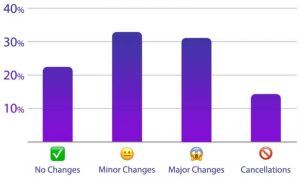Paid social can feel like a bit of a gimmick sometimes.
How do you assign value to a paid social ad like a Snapchat Filter or a Twitter Ad that targets your audience through emojis? Your followers may have ‘liked’ it and it may have gone viral on the platform… but what does that mean for your bottom line?
Most marketers’ report that proving ROI is their biggest challenge. It’s dizzying just thinking about the number of channels and devices to measure across. Americans now own four digital devices on average, and the average U.S. consumer spends 60 hours a week consuming content across devices.
When it comes to your paid social strategy, what is the best way to measure success and streamline your analytics across all of your channels?
Here are the seven paid social metrics you should be tracking:
BIDDING & BUDGET
1) The Bid
Social platforms, especially newer channels like Instagram and Snapchat, limit or curate their ads to avoid disrupting the user experience.
That’s why most social channels use a bidding system for their paid ads where advertisers auction for real estate on the feed. Advertisers often bid on factors such as time, location, and audience. The more popular the ad slot, the more expensive the bid. The strategy here is to hit the sweet spot, where you get the most value without overreaching your budget.
Bidding systems are run with two different options: CPM and CPC.
2) CPM: Cost-Per-Thousand Impression
CPM, most commonly known as cost per 1,000 impressions, is the cost for every 1,000 unique displays or views your ad receives.
CPM is good for brands looking to boost awareness, since you pay purely for reach and not for performance. This bidding model also works really well for brands with high click-through rates. With CPM, you get more clicks for less – let’s say you are paying $ 1 for 1,000 impressions, your cost doesn’t increase whether one person clicks or all 1,000 people click.
Unfortunately, there’s very little information on what each social channel considers an impression. For example, on Facebook, an impression is when an ad shows up as a user browses their Newsfeed, but does it register only after the user has paused their scrolling, or does it still register if the user scrolls past it? No one can be sure.
Ultimately, a high volume, high performing CPM ad can be a cost savings over a CPC ad, but you don’t take your impression counts at face value.
IDEAL FOR: If your paid social strategy is focused on building brand awareness around a new product and you just want to get it in front of as many people as possible, this is the bidding model for you.
3) CPC: Cost-Per-Click
CPC is the cost for each time a user clicks on your ad. The CPC model guarantees that you’re paying for ads that generate results. For brands with lower budgets or limited resources, CPC is a friendly alternative to the CPM.
If you have a strong sales funnel, CPC can also be a sure-fire way to drive quality leads to convert.
Do keep an eye on how your CPC corresponds to conversions. If you are paying for a high number of clicks but don’t see it move your bottom line, it can mean that you need to reevaluate the post-click experience.
IDEAL FOR: If you’re just getting started with paid social or find the CPM is too pricey for your budget, try out the CPC bidding model. CPC is also ideal for brands with hyper-targeted content.
ENGAGEMENT & INFLUENCE
4) Audience Growth Rate
Another way to track paid social success is by keeping tabs on how your follower size grows. A positive growth rate shows that your content is resonating with your audience.
This engagement metric should be tracked alongside likes, retweets and favorites, which help gauge the success of individual content pieces.
IDEAL FOR: If your paid social strategy is about building up your social community, this is the metric you’ll want to keep an eye on.
5) Potential Reach
Potential reach shows an estimated number of users your post will reach.![]()
This metric can be helpful when it comes to setting your target audience and planning your budget.
IDEAL FOR: On LinkedIn, you might want to take a look at your potential reach when you are deciding between targeting eCommerce CMOs in New York City versus eCommerce CMOs in California. You might find that your audience in California is a little too big and would dry out your budget too early, in which case you would narrow down your targeting.
ROI
6) Click-through-rate (CTR)
Click-through-rate is the total number of users who click on your ad divided by the total number of times the ad was served. The higher your CTR, the more compelling your content and call-to-action.
However, be cautious of click-through-rates that native analytics dashboards provide within the social platform. Facebook, for example, counts all clicks, not just link clicks. These numbers might make it look like your ad is outperforming other social channels that only count link clicks.
7) Conversion
Paid social drives 25% more conversions than organic social because the content is more targeted and timely.
A conversion is when a user takes an action that you want them to take, like a purchase, a visit to a landing page, a download or more. Many social channels will provide tracking pixels to add to your website, which helps track a user’s journey from the channel to your site.
Know Your Channels
At the end of the day, the way you use these metrics will vary depending on your goals and which paid social channel works best for you.
Not only does each channel have a slightly different way of calculating metrics, but each of them serve a different purpose in the conversion funnel.
The key to optimizing your paid social strategy is to start from the top down. First understand where your customers are engaging and how they are moving through the funnel before building out each individual channel.
Digital & Social Articles on Business 2 Community(48)






